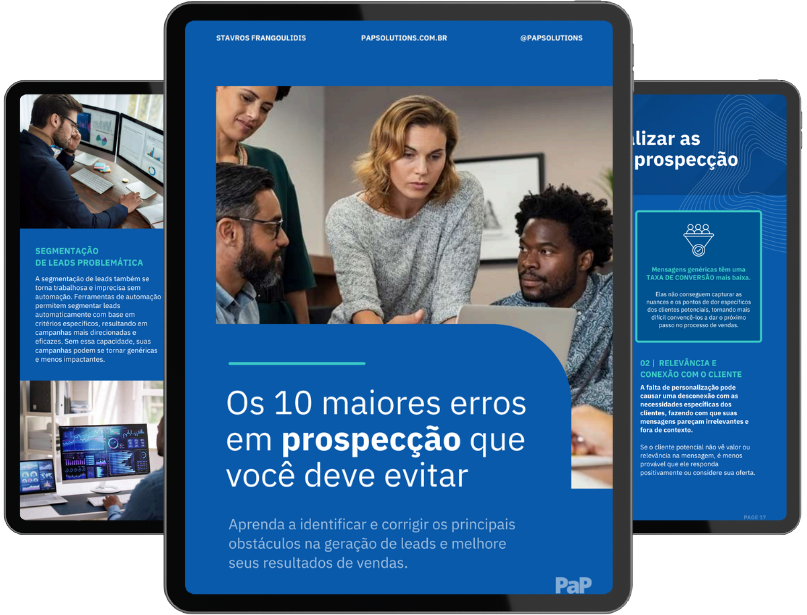Sua lista de clientes é um ativo.
Seu processo de prospecção é um ativo.
Seus produtos são ativos.
Suas campanhas são ativos.
Ativo é tudo aquilo que “juntado” a outros ativos traz receitas para sua empresa.
Por exemplo: Produto + Campanha => Receitas com lucro.
Cuidar dos ativos é fundamental.
Agora, eles devem ser complementares, congruentes e afins entre eles mesmos.
Produto Certo + Campanha Errada = Receitas, mas com prejuízo.
Pegue qualquer ativo e veja se o mesmo de encaixa no restante.
Esse exercício deve ser permanente, pois a partir do momento que a sua junção produz resultados, a máquina de vendas pode ser melhorada. E para tanto é necessário ajustar (permanentemente) o encaixe entre os ativos.
Como em tudo há um limite.
Você pode ter afinado muito bem uma campanha de prospecção para um determinado produto e ter alcançado uma excelente geração de leads e depois clientes.
Isso se deve à ótima sinergia entre os ativos e a resposta de mercado. Todavia, o resultado final pode e vai alcançar um platô, um patamar.
Isso se deve a diversos fatores, como tamanho de mercado e competitividade.
Nesses momentos é necessário uma revisão e uma detalhada análise dos ativos em jogo para uma definição de onde apostar:
Aumentar a capacidade de prospectar?
Investir mais em campanhas?
Novos produtos?
Apostar na melhoria da recorrência de compras na carteira atual de clientes?
O driver para o crescimento é intrínseco ao sistema corporativo. Você cresce ou perece.
Nem pense em ficar estagnado. A transitoriedade dos dias de hoje, vai zerar a produtividade dos seus ativos, se você não se remodelar a toda hora.
Portanto a estratégia de crescer é vital. O exercício em si de verificar a potência dos seus ativos é extremamente saudável para os negócios. Obriga-nos a pensar onde e como melhorar para, no mínimo, manter os números e em sequencia crescer em escala.
Crescer em escala significa, mais receita por ativo disponível.
Uma empresa que cresce a cada ano e onde seu maior cliente tem não mais que 5% do faturamento, é uma empresa que está em escala.
Uma empresa em escala tem seus ativos abocanhando cada vez mais share de mercado.
Como você percebe, os ativos são fundamentais para sua competitividade.
Quando vejo baixa produtividade na vendas, peço para abrir os ativos.
- Como está o processo de prospecção (se é que existe?)
- Como são medidos e em que frequência os resultados das campanhas de geração de leads (se é que existem)?
- Como está a competitividade dos produtos?
- Há uma estratégia clara de entrada em novos clientes com produtos de baixa fricção?
Com as respostas posso claramente discernir onde está o problema e criar uma lista de prioridades para a empresa.
Por exemplo.
Um empresa gera leads em profusão com campanhas de inbound, mas converte muito mal.
Possíveis áreas com problema:
- Sua página de vendas está atraindo o público errado (sem condições de comprar)
- A oferta é de alto risco para os leads, mesmo que qualificados.
- A execução (atendimento, reuniões, apresentações e propostas) afasta em vez de aproximar potenciais clientes.
É um desses três.
A boa notícia, é que o conserto é bem rápido e simples, desde que saibamos em qual ativo mexer.
No exemplo acima, o produto é bom (gera interesse de mercado) mas a campanha precisa de alguns retoques. O que é simples de fazer.
Aqui falamos em mudar texto, mudar a comunicação. Falamos em clicar em botões e digitar palavras.
A tecnologia nos dá uma quase instantaneidade entre o que emanamos e o que o mercado responde.
Portanto é simples consertar os problemas e recolocar as coisas nos trilhos da receita saudável.
Um outro exemplo, muito comum: Falta de receitas.
O problema está, claro, na geração de leads qualificados.
Para gerar leads é necessário investir.
Logo vem a pergunta, onde posso investir com o menor risco possível.
Resposta: Em seu(s) produto(s) e depois nos seus primeiros raios de ação.
Gere listas internas e passe para o seu melhor mercado os benefícios do seu melhor produto.
Esse é o investimento de menor risco para você, desde que seus ativos sejam produtivos. O contrário é fazer espuma e perder tempo e energia.
Depois você deve pensar em montar uma célula de prospecção que nunca mais pare de operar.
Entre R$ 5-10 mil por mês você monta uma estrutura de geração de leads para você, que pode ser escalável facilmente. Essa estrutura vai te gerar leads qualificados.
E depois você pode pensar em campanhas inbound que trarão uma quantidade muito maior de leads mas de menor qualificação. Uma campanha-teste B2B vai te sair na faixa dos R$ 10-30 mil.
Novamente os números te trarão as respostas do quanto esses ativos estão operando a seu favor e onde e em quais peças da máquina ajustar.
E qual aprendizado deixam.
De toda forma, você conta com uma máquina.
A máquina que processa ativos em receitas e lucros.

